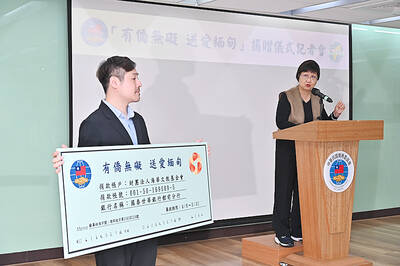More than 100 people walked under indoor artificial trees and on wooden boards mimicking forest trails with green plants alongside them and sounds of insects in the air, as they learned about Taiwan’s forests and nature conservation in a public exhibition at Huashan Creative Park in Taipei yesterday afternoon.
In celebration of the Republic of China’s centenary and the UN’s International Year of Forests, the Forestry Bureau opened an exhibition on Friday to share with the public the history, challenges, policies and future prospects of forestry in Taiwan.
At the opening ceremony, Forestry Bureau Deputy Director-General Yang Hung-chih (楊宏志) said that because of the unique geological environment in Taiwan, 58 percent of the country’s land was covered with forests, so forests have always linked together life on the island and thus hold treasures of cultural, social, economic and ecological benefits.
Yang also said the exhibition would introduce the diversified aspects and roles of forests, not only the ecology of abundant species, land security and recreational usage, but also their important roles in maintaining water sources and carbon sequestration — the capturing of carbon dioxide from the atmosphere.
The exhibition is divided into eight sections by topic, such as the technology of aerial photography and remote sensing; 100 recommended forest trails and 18 National Forest Recreation Areas; forestry culture and eco-friendly products; biodiversity; as well as other issues pertaining to ecological engineering and threats from invasive alien species.
Basic facts about Taiwan’s ecosystem were revealed, telling visitors there are about 950 million trees, more than 5,300 species of animals and plants, an average of 2,510mm of rainfall per year (about 3.44 times more than the world’s annual average) and that forests holds 26 percent more water than farmland in the country.
Visitors enjoyed a hands-on experience to understand how aerial photography and remote sensing functions in natural resource and disaster investigations. Numerous colorful photographs, samples and videos of animals and plants from forests were displayed, as well as handmade artifacts made of wood, sponge cucumber, seeds and other natural materials. Some visitors gazed at terrain models while guides explained the design and actual effects of different types of fish ladders.
To emphasize the concept of forest protection and carbon reduction, all exhibition displays and stages were made from recycled materials and could be recycled after use, the bureau said.
The exhibition is free and runs through Saturday. It is open from 9:30am to 6pm. Lectures and activities for parents and children will be held throughout.

Taiwan is stepping up plans to create self-sufficient supply chains for combat drones and increase foreign orders from the US to counter China’s numerical superiority, a defense official said on Saturday. Commenting on condition of anonymity, the official said the nation’s armed forces are in agreement with US Admiral Samuel Paparo’s assessment that Taiwan’s military must be prepared to turn the nation’s waters into a “hellscape” for the Chinese People’s Liberation Army (PLA). Paparo, the commander of the US Indo-Pacific Command, reiterated the concept during a Congressional hearing in Washington on Wednesday. He first coined the term in a security conference last

DEFENSE: The National Security Bureau promised to expand communication and intelligence cooperation with global partners and enhance its strategic analytical skills China has not only increased military exercises and “gray zone” tactics against Taiwan this year, but also continues to recruit military personnel for espionage, the National Security Bureau (NSB) said yesterday in a report to the Legislative Yuan. The bureau submitted the report ahead of NSB Director-General Tsai Ming-yen’s (蔡明彥) appearance before the Foreign and National Defense Committee today. Last year, the Chinese People’s Liberation Army (PLA) conducted “Joint Sword-2024A and B” military exercises targeting Taiwan and carried out 40 combat readiness patrols, the bureau said. In addition, Chinese military aircraft entered Taiwan’s airspace 3,070 times last year, up about

A magnitude 4.3 earthquake struck eastern Taiwan's Hualien County at 8:31am today, according to the Central Weather Administration (CWA). The epicenter of the temblor was located in Hualien County, about 70.3 kilometers south southwest of Hualien County Hall, at a depth of 23.2km, according to the administration. There were no immediate reports of damage resulting from the quake. The earthquake's intensity, which gauges the actual effect of a temblor, was highest in Taitung County, where it measured 3 on Taiwan's 7-tier intensity scale. The quake also measured an intensity of 2 in Hualien and Nantou counties, the CWA said.

The Overseas Community Affairs Council (OCAC) yesterday announced a fundraising campaign to support survivors of the magnitude 7.7 earthquake that struck Myanmar on March 28, with two prayer events scheduled in Taipei and Taichung later this week. “While initial rescue operations have concluded [in Myanmar], many survivors are now facing increasingly difficult living conditions,” OCAC Minister Hsu Chia-ching (徐佳青) told a news conference in Taipei. The fundraising campaign, which runs through May 31, is focused on supporting the reconstruction of damaged overseas compatriot schools, assisting students from Myanmar in Taiwan, and providing essential items, such as drinking water, food and medical supplies,